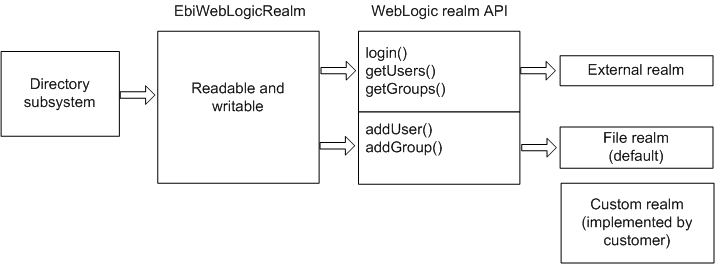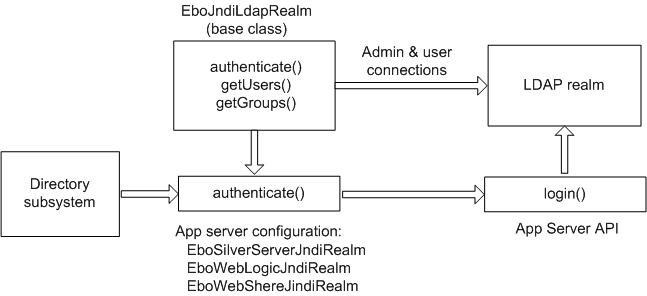


              |  |
 |
 |
 |
 |
 |
 |
 |
 |
 |
 |
User Management Guide
CHAPTER 1
This chapter summarizes the pluggable realm implementations of exteNd Director and provides information about configuring realms. It has these sections:
NOTE:  For information about configuring realms, see the section on directory configuration in Developing exteNd Director Applications.
For information about configuring realms, see the section on directory configuration in Developing exteNd Director Applications.
A realm is an exteNd Director application's interface to a persistent repository of users, groups, and passwords. In an exteNd Director application, a realm is a class that implements the interface EbiRealm or EbiWritableRealm.
These are the types of pluggable realms:
Realms can be either readable (read-only) or writable (read-write) as described below. For details about each realm, see the section on directory configuration in Developing exteNd Director Applications.
This section describes the pluggable realm implementations for supported J2EE application servers (non-LDAP).
This realm uses the exteNd Application Server Directory APIs and can be configured to use LDAP, Windows NT, SilverUsers, and NIS+ security providers. The LDAP and Windows NT security providers are read-only.
NOTE: If you are using eDirectory on the exteNd Application Server, it is recommended that you use the exteNd LDAP realm.
The EbiSilverServerRealm interface provides access methods to the exteNd Application Server realm:
|
Interface: |
EbiSilverServerRealm |
|
Implementation: |
EboSilverServerRealm |
|
Authentication provider: |
SilverSecurity (default) NTSecurity LDAPSecurity NISPLUSSecurity |

This realm exists for compatibility with ePortal 2.x directory services or any application that requires nested groups. It uses a set of database tables for user and group bindings. It also uses the exteNd Application Server realm's SilverUsers directory as its user repository:
|
Interface: |
EbiUserManagerRealm |
|
Implementation: |
EboUserManagerRealm |
|
Authentication provider: |
SilverUsers |
This realm is for BEA WebLogic 6.x. It calls the underlying server API to provide readable access to external realms (LDAP and Windows NT) and readable/writable access to the default realm stored in the file system on the application server.
The exteNd Director EbiWebLogicRealm interface provides access methods to the WebLogic server realm API:

|
Interface: |
EbiWeblogicRealm |
|
Implementation: |
EboWeblogicRealm |
|
Authentication provider: |
WebLogic internal store |
This realm is for IBM WebSphere 4.x and 5.x. exteNd Director accesses data through a custom registry based on a relational database to provide directory services. (IBM WebSphere does not provide a realm-access API other than authentication.) All method calls go through the exteNd Director database.
For authentication, the exteNd Director EbiWebSphereRealm interface calls the WebSphere authentication method, which in turn calls through to the database:

|
Interface: |
EbiWebsphereRealm |
|
Implementation: |
EboWebsphereRealm |
|
Authentication provider: |
AUTHUSERS (exteNd Director internal store) |
For writable LDAP realms, exteNd Director provides:
A generic base class that implements the Java Naming Service Interface (JNDI) (JNDI is the standard way in Java to access an LDAP realm hierarchy)
A derived class for each supported J2EE application server to authenticate users using a Novell eDirectory LDAP realm.Base LDAP realm
The JNDI realm base class provides an administrator connection to the LDAP server for retrieving groups and users. This connection is internal, and thus unauthorized external access to data is prevented. A user's JNDI connection is stored as part of the user session when the user is authenticated through the realm:

The base class supports generic LDAP authentication only and does not provide authentication through an application server. This latter is provided by a separate class for each application server. The application server realm overrides the authenticate method in the JNDI realm super class and uses the Application Server API for authentication
This is a generic realm that can be used to access users and groups directly from the exteNd Director database using the Directory subsystem API. It does not rely on any native application server APIs:

|
Interface: |
EbiPersistMgrRealm |
|
Implementation: |
EboPersistMgrRealm |
|
Authentication provider: |
AUTHUSERS (exteNd Director internal store) |
You can implement your own realm to directly access a directory server—or you can rely on an existing database structure. You can create a custom security realm by implementing these interfaces in the com.sssw.fw.directory.api package:
 For more information, see Configuring a custom realm.
For more information, see Configuring a custom realm.
You can configure the realm used in an exteNd Director application automatically or manually.
You can configure the realm used in an exteNd Director application in the exteNd Director development environment using either of the following tools, which perform exactly the same function:
exteNd Director Project Wizard—for new projects
 For a full description of the wizard, see the section on creating a project in Developing exteNd Director Applications.
For a full description of the wizard, see the section on creating a project in Developing exteNd Director Applications.
exteNd Director Configuration Tool—for existing projects
 For a full description of the tool, see the section on reconfiguring an exteNd Director application in Developing exteNd Director Applications.
For a full description of the tool, see the section on reconfiguring an exteNd Director application in Developing exteNd Director Applications.
Two descriptor files contain editable key/value pairs representing your application's realm and Directory subsystem configuration properties. The files are located in your project tree in the DirectoryService-conf folder.
|
Descriptor |
Contents |
For information, see |
|---|---|---|
|
config.xml |
Realm configuration properties |
The section on changing configurations in Developing exteNd Director Applications |
|
services.xml |
Directory subsystem service configuration |
This section applies to exteNd Application Server realms only.
The default realm for the exteNd Application Server is SilverUsers. You can reconfigure your realm to be any of the authentication providers supported by the exteNd Application Server, including Windows NT and NIS+.
 To configure a different authentication provider:
To configure a different authentication provider:
In exteNd Director, open config.xml for the Directory subsystem:
For each key/value pair, double-click the Key field and the Value field and enter these values:
NOTE: If you want to reconfigure your primary realm, see Configuring the primary realm.
 For deployment information, see the chapter on deploying an exteNd Director project in Developing exteNd Director Applications.
For deployment information, see the chapter on deploying an exteNd Director project in Developing exteNd Director Applications.
By default, the readable realm is the primary realm. For API method calls, the Directory subsystem checks the primary realm first.
 To specify your writable realm as the primary realm:
To specify your writable realm as the primary realm:
In exteNd Director, open config.xml for the Directory subsystem.
Open your project's Directory service descriptor:
...\library\DirectoryService\DirectoryService-conf\services.xml
 For more information, see the section on deploying an exteNd Director project in Developing exteNd Director Applications.
For more information, see the section on deploying an exteNd Director project in Developing exteNd Director Applications.
To write a custom pluggable realm, you need to implement the interface com.sssw.fw.directory.EbiRealm (for a readable realm) or EbiWriteableRealm (for a writable realm).
 For more information, see Writing a custom realm.
For more information, see Writing a custom realm.
In exteNd Director, open services.xml for the Directory subsystem.
In exteNd Director, open services.xml for the Directory subsystem.
If your realm is readable-only, enter a key/value pair that matches the value you entered in services.xml:
If the custom realm is readable/writable, add the same value with this key:
 For more information, see the section on deploying an exteNd Director project in Developing exteNd Director Applications.
For more information, see the section on deploying an exteNd Director project in Developing exteNd Director Applications.
Copyright © 2004 Novell, Inc. All rights reserved. Copyright © 1997, 1998, 1999, 2000, 2001, 2002, 2003 SilverStream Software, LLC. All rights reserved. more ...